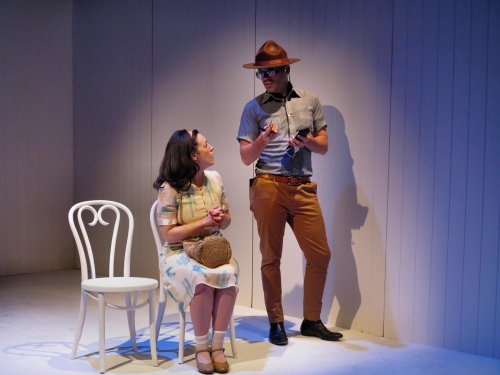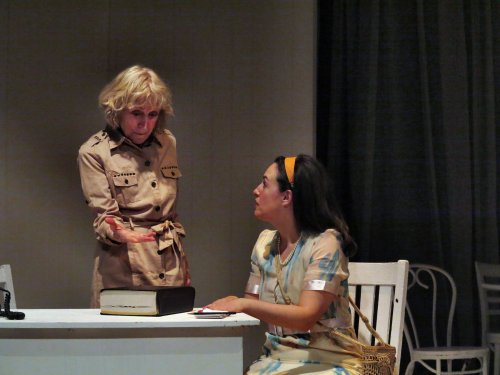Freedom Summer
A semi-autobiographical story of the playwright's experiences in the summer of 1964 as a college student risking her life in the cause of racial justice.

Clara Francesca as Sylvie and Arianne Banda as Terry in a scene from Toby Armour’s Freedom Summer at Theater for the New City (Photo credit: Jonathan Slaff)
[avatar user=”Scotty Bennett” size=”96″ align=”left”] Scotty Bennett, Critic[/avatar]
In the summer of 1964, Mississippi was a foul and evil place for a person of color, but it wasn’t just that summer in Mississippi; it was every summer after slavery ended, going back to the 1870’s. In 1964 the core character of that state became focused on another group, college students from all over the country, both black and white, but mostly white. They had traveled to that racist cradle of the War of Rebellion (Civil War) to register historically disenfranchised black citizens. Despite the challenges and dangers, “Freedom Summer” profoundly impacted the civil rights movement. The summer of 1964 was a significant moment in the fight for civil rights in the United States, illustrating the bravery and determination of the individuals who worked to combat racial injustice and promote equality.
Freedom Summer, written by Toby Armour and directed by Joan Kane, is a semi-autobiographical story of the playwright’s experiences that summer as one of those students risking their lives in the cause of racial justice. It is an important story in the present time as the same “Jim Crow” racist attitudes that controlled the social and political structures of Mississippi in 1964 have come out of the shadows in an effort to restore the white supremacist mechanisms of voter suppression and control. Unfortunately, this play does not deliver the drumbeat of tension that a deeply felt sense of fear, bordering on terror, engenders. That type of feeling was experienced by the participants that summer. Sadly, this production does not well serve that critical, timely subject matter.
The story follows Sylvie (Clara Francesca), a graduate student from Boston, as she makes her way to Jackson, Mississippi, in support of a voter registration drive being coordinated by the Congress Of Racial Equality (CORE) and the Student Non-violent Coordinating Committee (SNCC). She has little understanding of the conditions surrounding the project she has volunteered to participate in. It is a dangerous time in the southern United States. It is a time when police, white citizens’ councils, and the KKK are using arrests, arson, and murder against blacks and anyone who supports them. These groups opposed anything that would upset the status quo of segregation and voter suppression, precisely what the Mississippi Summer Project called “Freedom Summer” was designed to do.

Clara Francesca as Sylvie and Tim Dietrich as State Trooper in a scene from Toby Armour’s Freedom Summer at Theater for the New City (Photo credit: Jonathan Slaff)
In the home that Sylvie is assigned to, she meets Terry (Arianne Banda), a young black woman from a rural Mississippi town. The contrast between the lives of the two women is evident from the outset. Sylvie is a white woman on an adventure in social activism, and Terry is dealing with the stark reality of the world she was born into.
The show alternates between the critical moments each woman encounters over the summer. Sylvie has encounters with the state police, a racist white woman, the fear of the people she is trying to convince to register to vote, and her experience as a spy in the white community gathering information in support of the efforts of the voter registration volunteers. Her danger and emotional stress are brought out through the simple actions of being seen with black children in her car or asking someone for directions. She ends her time in Mississippi by working as a teacher in one of the Freedom Schools set up by SNCC/CORE to teach black children about their history, something denied to them by the segregated Mississippi schools.
In her effort to register voters, Terry encounters rejection and fear from the residents of the black communities. They are in a constant state of fear from having been intimidated by white supremacists for generations. Terry shares that fear when she realizes the police are following her in some communities. When she speaks with her mother, she discovers the harassment her mother is experiencing from members of the Ku Klux Klan because they think that Terry is working with civil rights groups. Despite these stresses, she helps organize a summer adventure to a farm swimming hole for a group of children. Even then, the fear of being discovered by the white authorities casts a pall over her enjoyment of the children having a fun-filled day.

Arianne Banda as Terry, and Debra Kahn-Bey and Clarence Comfort as a farmer couple in a scene from Toby Armour’s Freedom Summer at Theater for the New City (Photo credit: Jonathan Slaff)
There is a problem with how Terry and Sylvie tell their stories. Each addresses the audience with an introduction to the scene. When Sylvie arrives at the project headquarters after encountering a state trooper, she says, ” I’m in front of their Headquarters. Headquarters? No sign. Just two whitewashed windows on Lynch St. ‘Lynch St..’? Oh, boy!”
She continues with the description until she reaches the other characters in the scene. Terry does the same thing with many of her scenes. “It’s my first day! Canvassing for voters. In the colored part of town, of course. Knocking on doors. Up one side of the street and down the other. Here goes!”
The problem with these introductions is that they break any dramatic tension built into the scenes. An example is Sylvie’s encounter with a state trooper when she stops for gas outside Jackson. The encounter introduces a palpable fear and a sense of foreboding, feelings that must be maintained throughout the play to be true to the reality of the setting. The dialogue used to introduce later scenes breaks the tension created by the encounters with those opposed to what the Mississippi Summer Project is trying to achieve.
Francesca’s depiction of Sylvie is generally well-conceived. Still, I have issues with her transitions from a naïve, bright-eyed college student to a young woman immersed in a dangerous and terror-filled environment with the matter-of-fact narrator’s comments leading some of the scenes. Banda’s presentation of Terry captures the emotional conflict of a person exposed to the stress of growing up in a segregationist world. Still, she, too, has difficulty balancing that sense of the character with the moments of narration.

Beth Griffith as State House Librarian and Clara Francesca as Sylvie in a scene from Toby Armour’s Freedom Summer at Theater for the New City (Photo credit: Jonathan Slaff)
The four actors of the ensemble, Clarence Comfort, Tim Dietrich, Beth Griffith, and Debra Khan-Bey, are tasked with presenting an extensive array of characters that range from state police troopers to neighborhood children, from community residents to members of the KKK and to influential people who visited Jackson in support of the project. They even take on the roles of Sylvie and Terry’s mothers. Although they play this panoply of characters with varying degrees of success, it is too much for this small group to deliver the dramatic impact needed from some of the characters being portrayed.
The set design by Mark Marcante and Lytza Colón is stark white and minimalist, with some chairs, tables, and telephones as props. The back wall has a screen that looks like an open book where Jim Marlowe’s projection design of images from the civil justice struggles from then and now are projected is more of a distraction than a statement about the issues being depicted. The set’s color is also distracting, given the darkness of the subject matter.
The light design by Alex Bartenieff effectively moves the action from point to point in the story while dealing with the limitations of the set design. Billy Little’s costume design defines the characters’ nature in small but significant ways, such as a “Smokey the Bear” hat effectively depicting a state trooper without the need for a full police uniform.
Freedom Summer (through June 25, 2023)
Theater for the New City, between 9th and 10th Streets, 155 First Avenue, in Manhattan
For tickets, call 212-254-1109 or visit http://www.TheaterForTheNewCity.net
Running time: 90 minutes without an intermission






Leave a comment